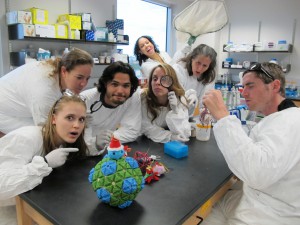 Among the lush armchairs and hissing espresso machines, a Popular Science magazine Brilliant 10 honoree patters away at her keyboard at the Campus Grind.
Among the lush armchairs and hissing espresso machines, a Popular Science magazine Brilliant 10 honoree patters away at her keyboard at the Campus Grind.
Breitbart, 35, finds solace in the bustle of the coffee shop, just a few steps away from her lab. She landed her title as one of North America’s leading young scientists through her study of metagenomics, a branch of biology focused on the genetics of viruses, which she helped pioneer.
In metagenomics, instead of studying the genomes of individual viruses, scientists observe a community of viruses in different environments, such as seawater from Bayboro Harbor. The studies allow scientists to discover what type of viruses can be found in a given sample.
“It’s like putting a thousand jigsaw puzzles all together,” Breitbart said. “We have all of these little pieces of sequences that we’re trying to put back together into genomes.”
Her career has revolved around studies of viruses in the ocean and insects, or as she calls them, “flying syringes.” She has found insects to be the most dangerous infectors of viruses.
One of Breitbart’s studies concluded that plant viruses are common in human waste. She discovered an abundant pepper virus in human sewage, a finding she believes would have remained unknown without actively searching for it.
“You would never know that because you would never go looking for it,” Breitbart said.
“This method (metagenomics) we used let us go in without our blinders on and without any expectations for what we’re going to find.”
Research vessels whisk Breitbart as far away as Bermuda, the Florida Keys and various parts of the North Atlantic. Recent studies of copepods, such as plankton, allowed Breitbart and students to collect and study them for viral sequences.
“Mya’s work shows that scientists working in the oceans are working on problems of global significance,” said Jacqueline Dixon, dean of the USF College of Marine Science.
“Her science focuses on viruses in the oceans, but the fundamental ideas can impact a much broader range of biology, medicine, and marine science.”
The next step for Breitbart’s research is making it applicable. Ideas for doing so include having information available at health clinics and using certain findings to foster environmental protection.
Keeping her Popular Science recognition a secret was challenging for Breitbart. She received word in May but was told to not share the news until after publication of the October issue. After the magazine hit the newsstand, she received an influx of contact from former students, teachers and mentors.
Breitbart credits her success to San Diego State University Ph.D. advisor Forest Rohwer, who, recognizing her excitement, gave her a chance to excel in the field.
“I had people sort of take me under their wing and do research in their lab, even back when I knew next to nothing and I credit those people for getting me where I am today,” Breitbart said.
Recognition is also in order for current and former students.
“They don’t really get the recognition they deserve a lot of times … I won this this award, but really it was based on work they were doing,” Breitbart said.
“They have been at the frontlines, they have been out in the fields collecting samples, getting bitten up by the bugs, processing all of the samples … every step of the way.”
Breitbart seeks to be a role model for women in science and encourages young science students. She teaches a first year graduate professional development course, which allows her to mentor students.
“That’s the part of being a professor here that I actually like the best … seeing when a student comes into my lab and when I get them excited about doing research, and then when they go off to graduate school or to do a post-op somewhere and succeed,” Breitbart said.
“I’ll always be watching to see what they’re publishing or how they’re doing, knowing that they got their start with some help from me.”
Travel opportunities with research have taught Breitbart to always carry a camera, capturing images of otters, birds and natural landscapes.
“I like having both sides of my life highlighted at the same time,” Breitbart said of her photography. “It’s exciting for me to show off my artistic side as well as talk about what I’m doing as part of my day job teaching research.”
Sept. 5 marked the grand opening of Breitbart’s wildlife photography exhibition at the Campus Grind, which is still on display.



